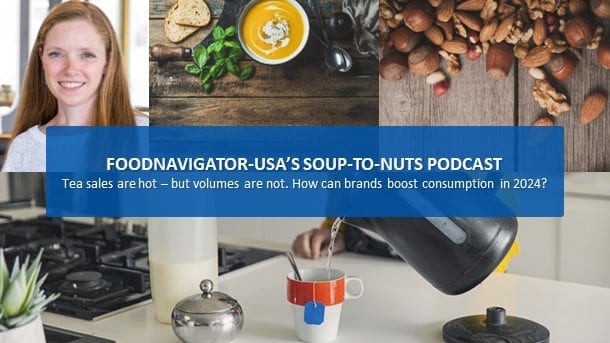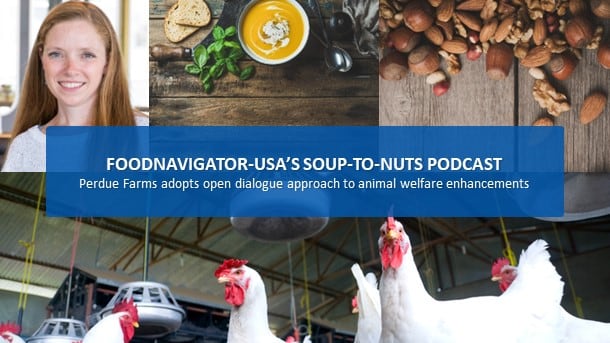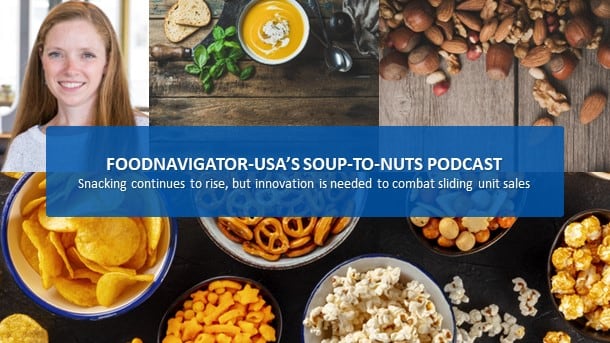According to Statista, the US tea market is expected to bring in $2.8bn in revenue in 2024 – the same as in 2023, which represents a slowdown from a notable 7.69% uptick in revenue from $2.6bn in 2022 and a 4% and 4.17% year-over-year increase from 2021 and 2020, respectively. While Statista expects to see renewed revenue growth of a more modest 3.2% compound annual rate over the next four years, volume is anticipated to increase only 0.9% through 2025 -- revealing a familiar disconnect between sales and volume that many food and beverage categories currently are experiencing.
Still, there are significant opportunities to drive tea consumption higher going forward.
In this episode of FoodNavigator-USA’s Soup-To-Nuts podcast, Carman Allison, NIQ’s vice president of thought leadership in North America and Shabnam Weber, president of the Tea and Herbal Association of Canada, share what is driving current consumer interest in tea, what emerging trends will fuel additional growth in 2024 and what challenges stakeholders must overcome.
[Editor’s note: Never miss an episode of FoodNavigator-USA’s Soup-To-Nuts podcast – subscribe today.]
That current state of the industry: What is behind tea’s fast growth & slowdown
The dramatic jump in tea sales between 2020 and 2022 and the subsequent slowdown in 2023 mirrors the experience of many food and beverage categories during the pandemic and following period of inflation, according to Allison, who adds the wild swings should not be alarming.
He explains that tea is riding the same waves as other food and beverage categories, many of which soared early in the pandemic only to see volumes level off as inflation set in.
“In 2020, when the whole world shut down, we saw record levels of growth in our industry. It was up about 11-12% across the board. We’ve seen things normalize a little but now we are seeing the big growth driver is rising prices,” and the subsequent challenge for may brands is that consumers are spending more but buying less, Allison explained.
“Part of that has to do with the fact that people are sticking with essentials. So some people are just removing things from their shopping list. Now, I don’t think tea and coffee are one of those categories that people are cutting back on to a huge degree,” but there is increased competition from foodservice and across different shopping channels compared to during the pandemic, he added.
Highlight tea’s affordability, diversity to drive sales during a difficult economy
As consumers continue to be more selective of how they spend their food and beverage dollars, Weber recommends brands and retailers highlight tea’s affordability compared to other beverages and versatility.
“It is a very, very affordable beverage, and, I think, it is an affordable beverage that is full of vitamins, minerals and health benefits. So, you are getting a lot of bang for your buck for the beverage that is out there,” she said.
But, she added, brands and retailers need to do a better job of communicating the value of tea – both on a dollar basis and in terms of benefits through storytelling that is easy to understand.
One way to highlight the value of tea – and help ensure its purchase – is to showcase different ways of consuming it, including different occasions. For example, Weber calls out the potential to tie tea into the burgeoning sober-curious movement, while Allison points to pairing it with different meals, day parts and benefits.
Creative merchandising could boost basket size, protect shelf space from downsizing
Allison also notes that tea’s versatility lends itself well to cross-promotional and merchandising activities.
“When you’re promoting your product, it is always great to find a complementary product” with which to cross promote, such as pairing tea with baked goods, immunity-boosting or cold and flu symptom-relief products, Allison said.
As brands work with retailers to cross-promote tea, Allison advises they should also be prepared for and push back against stores potentially cutting back on the variety and number of teas they stock.
One way to defend against cuts is to highlight the specific occasions to which a tea caters and how it might help drive incremental sales or foot traffic.
Time to innovate
Offering innovative teas is another way to secure shelf space in what can be a crowded category, according to Allison. He explains that innovation waned during the pandemic, but now is the time to turn it back on.
Weber notes a good place to innovate is around health, including the addition of herbals and botanicals that are associated with functional benefits and mood management, such as ashwagandha, medicinal mushrooms or other adaptogens.
Given the financial pressures many consumers are facing, Allison stressed that innovation does not have to equal premium pricing. Sometimes innovation is related to increased accessibility, such as through small packs with lower entry price points or sampler sets that lower the risk of trial for something new.
Other emerging innovation trends to watch, according to industry experts, are single origin and organic teas, nitro-infused tea, hibiscus and peach teas, matcha lattes that mimic the coffee-drinking experience and loose leaf teas, which are simultaneously viewed as more premium and a better value as it carries a connotation of lower prices associated with purchasing in bulk.




